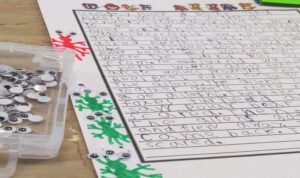
This is a great game to stimulate “SHOW DON’T TELL” thinking and also gives listeners an opportunity to make inferences.
Making inferences is a difficult skill for many students. This game teaches students how to write their own descriptive actions. The actions help the reader know how the character is feeling.
Having student write these descriptive actions to imply a feeling strengthens their ability to detect descriptive clues in passages that they read.
Short Teaching Video
Show your students this 6 minute video that teaches the concept of making inferences.
Common Core State Standards
Note that his game can address the following Common Core Standards: CCSS.ELA-LITERACY.W.2.3, W.3.3.B, W.4.3.B and W.5.3.B
Show Don’t Tell
“Show don’t tell” is a common phrase used when teaching children how to write. It means that students describe how a character feels by writing the characters’ actions rather than telling us their feelings directly.
Playing the Game
First, divide the children into groups of 2-3. Give each group an emotion on an index card.

The children have 5 minutes to write 3 actions that a person would likely do if feeling the emotion on the card.
The actions should be written in sentence form. Here are samples:
The young girl sat glaring at the ground.
She crossed her arms and shouted.
Then, she walked away without saying a word.
After the 5 minutes. Each group gets to read their sentences. The rest of the class has to guess which emotion the actions describe.
(This also creates an opportunity for the listeners to infer which can be a difficult skill for kids in school.)
Emotions
Here’s a list of emotions that you can use:
Afraid
Angry
Anxious
Disappointed
Embarrassed
Excited
Hungry
Nervous
Relieved
Shy
Surprised
Tired
Print the Instructions
Here are the instructions for you to print out and use.
Feel free to add ideas of your own!
We played this game after writing the Pet on a Porch fantasy prompt.

Check out more guided writing lessons under these genres!
Fiction



